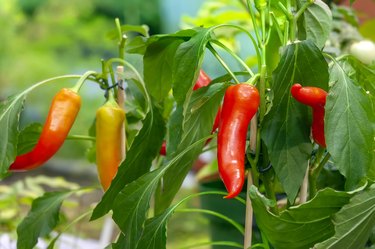
Mild and hot peppers (Capsicum spp.), also known as chilies, thrive in frost-free gardens in U.S. Department of Agriculture plant hardiness zones 9 through 11. While some gardeners swear by coffee grounds, pepper plants prefer the roasted and ground beans to be well-composted with other organic ingredients. Natives of the tropical Americas, pepper plants favor an evenly moist, organically rich soil to produce their tasty sweet, hot or molten-lava-level fruits.
About Pepper Plants
Video of the Day
Pepper plants range from sweet bell peppers to the tongue-melting Guinness World Record holder, the Carolina Reaper. Measured in Scoville heat units (SHU), the Carolina Reaper ranges from 1,569,383 to 2,200,00, while a bell pepper logs in at zero SHU.
Video of the Day
Whether you select sweet or hot peppers, start your seeds indoors six to eight weeks before the last frost in your area. Plant the seeds in peat pots and keep them warm and moist as the peppers germinate. Plant outside in the garden when soil temperatures rise above 65 degrees Fahrenheit. Keep the soil evenly moist and fertilize regularly through the growing season to support the plants as they grow, flower and fruit.
Benefits of Coffee Grounds
Coffee grounds, whether composted or mixed directly in the soil, help lighten the soil structure of clay soils and add organic matter to sandy soils. The used grounds contain a variety of compounds, including carbon and nitrogen, which support beneficial soil organisms. At a rate of 10 to 20 percent of the materials in a compost pile, coffee grounds help keep the temperature in the sweet spot between 140 and 160 degrees Fahrenheit.
The oft-repeated advice to add coffee grounds to the soil to lower the pH sounds good, but it's not true. The acid in coffee grounds is water soluble and leaches into the beverage as it brews, leaving little in the grounds. Coffee grounds are generally pH neutral at 6.5 to 6.8, which makes them ideal to add to the soil or compost pile.
When mixed into the soil or made into compost, the decomposing coffee grounds can suppress disease-causing microbes, such as the Fusarium, Pythium and Sclerotinia species. They also tend to discourage slugs and snails.
Disadvantages of Coffee Grounds
When used as a mulch, coffee grounds dry out and repel water and air. They need to be kept moist by covering them with compost or mulch or mixing them into the soil. If you're spreading coffee grounds directly over the soil, keep the layer 1/2 inch thick or less and cover with 4 inches of mulch.
At approximately 2 percent nitrogen by volume, coffee grounds don't add extra nitrogen for the peppers' roots when applied directly to the soil. In fact, you should add a little extra nitrogen fertilizer as the coffee grounds decompose so they don't affect the peppers' nitrogen uptake.
Apply Coffee Grounds to Pepper Plants
The best way to apply coffee grounds to pepper plants is to compost the used grounds and then side-dress the plants with a few shovelfuls of the well-decomposed material midseason after the plants begin blooming. Water well after adding the compost using a soaker hose or hose-end bubbler to keep the foliage, flowers and fruits dry.
Build your compost pile with up to 20 percent used coffee grounds plus equal parts green materials, like grass clippings and kitchen waste, and dried brown materials, like dried leaves and shredded paper. A few shovelfuls of garden soil or already decomposed compost add microbes to speed the composting process. Keep the pile moist but not waterlogged and turn regularly to mix the components as they decompose. When the compost is dark and crumbly and smells like a rich soil, it's ready to spread under and around your pepper plants.
- Missouri Botanical Garden: Peppers
- North Carolina Extension Gardener Plant Toolbox: Capsicum annuum
- Guinness World Records: Hottest Chilli Pepper
- Harvest to Table: How to Grow Peppers
- University of Minnesota Extension: Myth or Miracle: Coffee Grounds, Eggshells, and Epsom Salts?
- Oregon State University Extension Service: Coffee Grounds and Composting